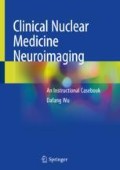Abstract
Dopamine transporter scan (DaTscan), as the name implies, is a brain SPECT imaging modality with 123I-ioflupane as the radioactive tracer that has a high binding affinity to striatal dopamine transporters. In 2011, FDA approved the clinical use of DaTscan in the US to help differentiate essential tremor (ET) from tremor due to Parkinson’s disease (PD), multiple system atrophy (MSA), or progressive supranuclear palsy (PSP). Such differentiation could be crucial for certain patients’ clinical diagnosis, choice of pharmacotherapy, and prognostic evaluation (Booij et al., Q J Nucl Med Mol Imaging 56:17–26, 2012; Davidsson et al., Ann Nucl Med 28(9):851–859, 2014; Gayed et al., Clin Nucl Med 40(5):390–393, 2015). A normal DaTscan is characterized by crescent-shaped tracer activity with highest tracer intensity in caudate nuclei tapering into putamen body and tail in both hemispheres. Since dopamine neurons in putamen are more vulnerable to neurodegenerative insults compared to those in caudate nuclei, an abnormal DaTscan manifests asymmetrically decreased tracer activity due to striatal dopamine neuron loss, depending on disease staging, typically initial affecting one of the putamens and then spreading into the contralateral putamen and/or the ipsilateral caudate nuclei and finally the caudate nuclei on both sides (Brooks, Parkinsonism Relat Disord 18S1:S31–S33, 2012; Meles et al., J Nucl Med 58:23–28, 2017; Pagano et al., Clin Med (Lond) 16(4):371–375, 2016). This unique neuroimaging pattern not only helps diagnose PD, but also assists in the differentiation of PD from Parkinsonism associated with or caused by other neurodisorders. Presented in this chapter are selected cases with probable normal DaTscan in patients with ET or neuroleptic-induced Parkinsonism, and abnormal DaTscans due to a variety of underlying causes, including probable early and advanced idiopathic PD, cerebrovascular accident (CVA)/stroke, arteriovenous malformation (AVM), corticobasal degeneration (CBD), PSP, and MSA.
Access this chapter
Tax calculation will be finalised at checkout
Purchases are for personal use only
References
Booij J, Teune LK, Verberne HJ. The role of molecular imaging in the differential diagnosis of parkinsonism. Q J Nucl Med Mol Imaging. 2012;56:17–26.
Brooks DJ. Parkinson’s disease: diagnosis. Parkinsonism Relat Disord. 2012;18S1:S31–3.
Davidsson A, Georgiopoulos C, Dizdar N, et al. Comparison between visual assessment of dopaminergic degeneration pattern and semi-quantitative ratio calculations in patients with Parkinson’s disease and atypical Parkinsonian syndromes using DaTSCAN SPECT. Ann Nucl Med. 2014;28(9):851–9.
Gayed I, Joseph U, Fanous M, et al. The impact of DaTSCAN in the diagnosis of Parkinson disease. Clin Nucl Med. 2015;40(5):390–3.
Kuo PH, Lei HH, Avery R, et al. Evaluation of an objective striatal analysis program for determining laterality in uptake of I-123-ioflupane SPECT images: comparison to clinical symptoms and to visual reads. J Nucl Med Technol. 2014;42(2):105–8.
Ling H. Clinical approach to progressive supranuclear palsy. J Mov Disord. 2016;9(1):3–13.
La M, Micallef C, Paviour DC, et al. Conventional magnetic resonance imaging in confirmed progressive supranuclear palsy and multiple system atrophy. Mov Disord. 2012;27:1754–62.
Meles SK, Tenue LK, de Jong BM, et al. Metabolic imaging in Parkinson disease. J Nucl Med. 2017;58:23–8.
Ogawa T, Fujii S, Kuya K, et al. Role of neuroimaging on differentiation of Parkinson’s disease and its related disease. Yonago Acta Medica. 2018;61:145–55.
Pagano G, Niccolini F, Politis M. Imaging in Parkinson’s disease. Clin Med (Lond). 2016;16(4):371–5.
Author information
Authors and Affiliations
Corresponding author
Rights and permissions
Copyright information
© 2020 Springer Nature Switzerland AG
About this chapter
Cite this chapter
Wu, D. (2020). Dopamine Transporter Scan (DaTscan). In: Clinical Nuclear Medicine Neuroimaging . Springer, Cham. https://doi.org/10.1007/978-3-030-40893-0_6
Download citation
DOI: https://doi.org/10.1007/978-3-030-40893-0_6
Published:
Publisher Name: Springer, Cham
Print ISBN: 978-3-030-40892-3
Online ISBN: 978-3-030-40893-0
eBook Packages: MedicineMedicine (R0)

